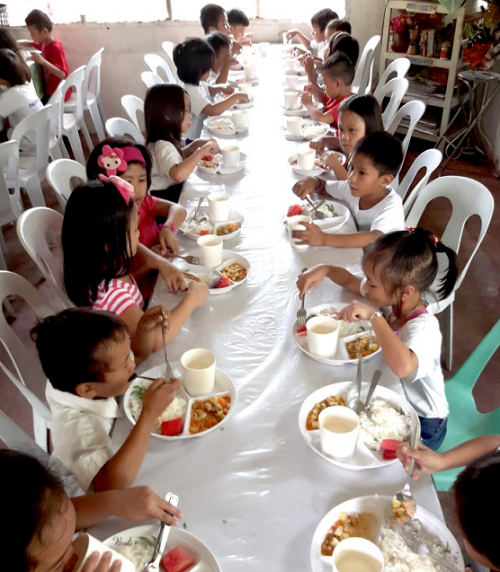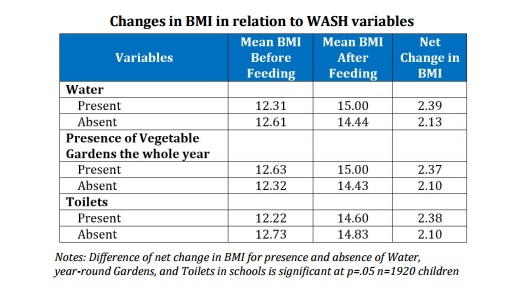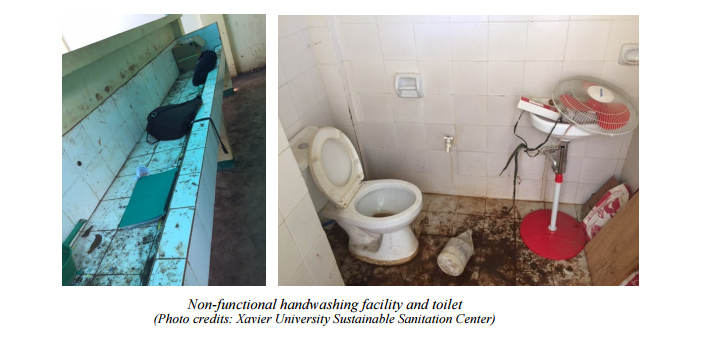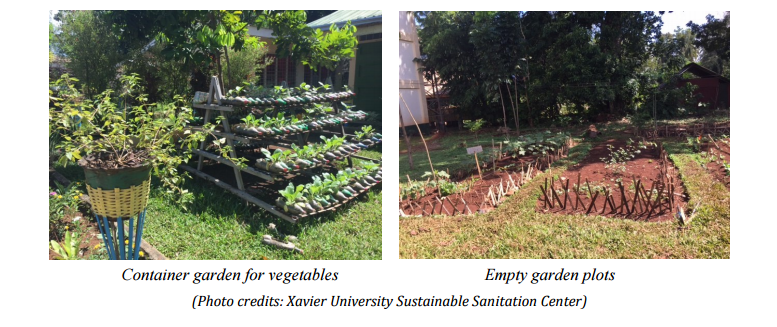
Policy Messages
1. Child nutrition contributes to the country’s overall development.
2. School-based feeding is crucial to the nutritional rehabilitation of children but it is not enough.
3. Good Water, Sanitation and Hygiene (WaSH) practices combined with school feeding gives better nutritional rehabilitation results.
Introduction
The Philippines is a middle-income country in South East Asia and is one of the ten (10) member countries of the Association of South East Asian Nations (ASEAN). In the last 10 years, the country has experienced rapid economic growth; 7% increase in its Gross Domestic Product (GDP) in 2016, and is projected to have a GDP growth of 7 – 8% for 2017 (www.neda.gov.ph, Statement of Secretary Ernesto M Pernia on the 2017 projected economic performance of the Philippines).
However, despite this rosy picture painted in the economic sector, child nutrition continues to be a challenge for the Philippines. The country ranks globally among the top ten for stunted children (Global Nutrition Report 2016 ). Public health measures such as school-based feeding and school gardening have been established by the Department of Education (DepEd) nationwide for many decades. However, 3 out of 10 school children aged 6 – 12 years old remain short for their age (stunted) and have not attained the optimum weight for their heights (wasted).
It is estimated that childhood stunting costs the Philippines almost 3% of its GDP. These economic losses result from the following:
a) Lost income as a result of lower level of education achieved by a working population who suffered from childhood stunting;
b) Lost productivity due to premature deaths among children
c) Additional education costs to cover grade repetitions linked to poor nutrition
Nutrition, therefore, has profound effects on human development. It impacts education, learning, employment, productivity, and eventually the ability of a country to develop. It is, therefore, imperative that child malnutrition is prevented and that better outcomes for nutritional rehabilitation are achieved.
Key Points
Schools play an important role in nutrition rehabilitation in the Philippines.
Schools are not only places of learning. For most children, it is also a safe, protective, and constant environment where they can be expected to develop their full potential.
Since 1997, the DepEd has implemented school-based feeding programs (SBFP). The department’s first SBFP was called as the Breakfast Feeding Program (BFP) and aimed to address short-term hunger. Through the years, the SBFP shifted focus from addressing short-term hunger to addressing chronic under nutrition among public school pupils (Tabunda AL et al. 2016).
The SBFP aims to: (1) rehabilitate at least 70% of severely wasted beneficiaries to normal nutritional status at the end of the feeding days; (2) ensure 85% to 100% classroom attendance of beneficiaries; and (3) improve children's health and nutrition values and behavior. According to the Health and Nutrition Center (HNC) of DepED, the primary goal of the SBFP is the nutrition goal; the others are secondary.
The SBFP of DepED involves feeding elementary school pupils for 100-120 feeding days per school year using a 20-day cycle of standardized recipes. Each meal has at least 300 calories; this is lower than 876 calories per meal in feeding programs done in other countries (Adelman et al. 2008). Furthermore, SBFP gives lower feeding days (120) compared to the 180 feeding-day-average in other developing countries (Bundy et al. 2009).
To implement the SBFP, each school head establishes its SBFP core group (CG), and involves volunteer parents in preparation of meals and feeding of children. The SBFP also devolves procurement and financial reporting; and is complemented with other DepEd programs of deworming, Gulayan sa Paaralan Program (School Gardening Program), and Essential Health Care Program (EHCP), which incorporates daily hand washing, and tooth brushing in the elementary school curriculum.
At present the budget for SBFP is Php18 per child a day. Of this total budget, 16 pesos goes for the budget of the school lunch, and 2 pesos goes to administrative and monitoring costs. Children who are moderately and severely wasted are prioritized and enrolled in SBFP.
Nutritional rehabilitation is better with school gardens and the presence of water and toilets in schools.

The Vegetables Go to School (VGtS) Program utilized the Department of Education’s secondary data for weight, height and Body Mass Index (before and after school feeding) of enrolled school children during school year 2014-2015. The project collected its own primary data before and after school feeding for the school years 2015-2016 and 2016-2017. Therefore, the data for height, weight and BMI which were analyzed for the project comprised 3 consecutive school years.
Sixteen schools under the DepEd Division of Cagayan de Oro City were included in the project. These schools were the following: Balubal Elementary School, Baluarte Elementary School, Balulang Elementary School, Bongbongon Elementary School, Bulua Central Elementary School, Canitoan Elementary School, Cugman Elementary School, Fr William Masterson Elementary School, Indahag Elementary School, Iponan Elementary School, Kiam-is Elementary School, Lapasan Elementary School, Lumbia Elementary School, Pedro Oloy N Roa Elementary School, Taguanao Elementary School, and Upper Carmen Elementary School.
After analyzing all the data, the following summary statements are evident:
• BMI increases with 120 days of school-based feeding
• BMI declines during vacation months
• BMI increase is better in schools with 24/7 potable water supply
• BMI increase is better in schools with toilets
• BMI increase is better in schools with year-round vegetable gardens
Constraints need to be addressed
There are many constraints that prevent the full attainment of nutritional rehabilitation with school-based feeding programs. The most relevant are:
a) Inadequate administrative support for the school based feeding program as evidenced by:
i. Frequent re-shuffling of teachers in charge of feeding and gardening;
ii. Inadequate training of replacement teachers;
iii. Lack of proper equipment to monitor weight and height (e.g weighing scales)
b) Water and WaSH facilities should be available in all schools
Many schools have no running water or at best water comes for a few hours on certain days of the week. The association between better nutritional rehabilitation results and WaSH is clearly shown in many studies (WHO, 2015 and Global Nutrition Report, 2016) as well as the experience of the Vegetables Go to School Project. When there is no running water, hand washing facilities and toilets remain unused and children are not able to benefit from healthy practices such as hand washing and using a functional toilet.

c) School gardens contribute to good nutritional rehabilitation outcomes
Many schools have vegetable gardens which do not last the whole school year (10 months) because of many reasons, such as lack of water, inadequate space for a garden, lack of a teacher in charge of gardening. Yet the data from the VGtS Project clearly highlights the fact that schools which have year-round vegetable gardens showed a better gain in BMI for children who were enrolled in the school based feeding program compared to schools which did not have year-round vegetable gardens.
Conclusion
Chronic malnutrition as evidenced by children being too short for their ages and being too thin for their heights is an important problem which should be addressed. Solving this problem enables children to achieve their full potential and eventually become productive adults who will contribute to nation building. Nutritional rehabilitation directly contributes to Sustainable Development Goal (SDG) 2 which aims to end hunger, achieve food security, improve nutrition and promote sustainable agriculture. Therefore, improved nutrition is the platform for progress in health, education, and employment which will eventually help the Philippines achieve through sustainable development.
References and Further Readings
Adelman, S., et al. How Effective are food for education Programs? A Critical Assessment of the Evidence from Developing Countries, Policy Review 9, IFPRI, Washington, D.C.
Bundy D et al. Rethinking School Feeding Social Safety Nets, Child Development, and the Education Sector. The World Bank.
International Food Policy Research Institute. 2016. Global Nutrition Report 2016: From Promise to Impact. Ending Malnutrition by 2030. Washington DC
Tabunda AL, Albert J, Angeles-Agdeppa I. Results of an Impact Evaluation Study on DepEd’s School-based Feeding Program. Philippine Institute for Development Studies Discussion Paper Series No. 2016-05.
World Health Organization 2015. Improving nutrition outcomes with better water, sanitation, and hygiene. WHO, Geneva, Switzerland.
www.neda.gov.ph. Statement of Secretary Ernesto M Pernia on the 2017 projected economic performance of the Philippines
Vegetables Go to School (VGtS) Project Partners
This Policy Brief was prepared with contributions from the following partners:

For the PDF version of this policy brief, click here.
